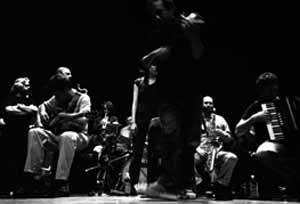
photo by Vera Marmelo
Variable Geometry Orchestra | 1999 | Lisbon | Portugal
Ernesto Rodrigues – conduction, violin, viola
Sílvia Freitas – violin
Kátia Santandreu – viola
Guilherme Rodrigues – cello
Miguel Pereira – contrabass
Sei Miguel - pocket trumpet
Pedro Portugal – trumpet
Marcello_Maggi – trumpet
Jean-Marc Charmier – trumpet, flugelhorn, euphonium
Fala Mariam – alto trombone
Eduardo Lála – trombone
Eduardo Chagas – trombone
Johannes Krieger – trumpet, french horn
Gil Gonçalves – tuba, euphonium
Miguel Bernardo – clarinet
Bruno Parrinha – clarinet, alto clarinet, alto saxophone, harmonica
João Viegas - bass clarinet
Jorge Lampreia – flute, soprano saxophone
Nuno Torres - alto saxophone
Lizuarte Borges - alto saxophone
Peter Bastiaan - alto saxophone, melodica, drums
Alípio C Neto – alto saxophone, tenor saxophone
Abdul Moimême - tenor saxophone, electric guitar
Ivan Fontes – didgeridoo
Olympia Boule – voice
Rodrigo Pinheiro – piano
Etsuko Kimura – organ
Armando Pereira – accordion
António Chaparreiro - electric guitar
Nuno Rebelo – amplified objects
Carlos Santos – computer
Travassos – “circuit bending”, tapes
João Pinto – computer
Nuno Moita – sampler, turntables
João Silva – field recordings, crackle box, tibetan bell
André Gonçalves – analog modular synth
Adriana Sá – digital synth
Rafael Toral – modified mt10 amp
Plan – turntables
Hernâni Faustino - double bass
Rachiim Sahu - double bass
Pedro Castello-Lopes – percussion
Jorge Oliveira - african percussion
César Burago - cowbell
Monsieur Trinité – cymbals, objects
José Oliveira – drums
The music produced by the Variable Geometry Orchestra
(VGO) results from the juxtaposition of acoustic and electronic sound
matter that constantly searches for detail and meaning. Its sounds contain
subliminal as well as psycho-acoustic characteristics and include the
possibility of complete silence. The music emerges as if from nothingness
only to disappear once again back into it. Thus chaos is formally organized
with the use of new concepts of indeterminism, instantaneous composition,
as well as through the asymmetrical eruption of alternated moments of
sound and silence (the absence of identifiable sound).
Nevertheless, sound prevails. The conduction is operated by
balancing the sound masses that travel in the acoustic space, dictating
the construction of the real-time composition, and thus revealing the
organized juxtaposition of specific instruments as mobile sound groups.
This leaves space for the musicians to regain their natural rhythm and
breathing, as well as their sense of random pulsation. It also allows
them to listen to all the sound events that are happening at any given
moment and thus to act accordingly. On the contrary, they can simply listen
to what another musician has just begun. The musical space is thus filled
only with the intrinsically essential elements.
Another of the outstanding aspects of the orchestra is how open it is
to new participants. That is one reason why it is called ‘variable’.
The influx of new creative power is tempered only with a truly democratic
spirit where hierarchy is reduced to a bare minimum, also permitting a
very large number of combinations and permutations of smaller ensembles
to be arranged on-the-spur-of-the-moment.
Last but not least, the orchestra encompasses three generations of musicians
who have set age aside to pursue a common contemporary language.
Ernesto Rodrigues